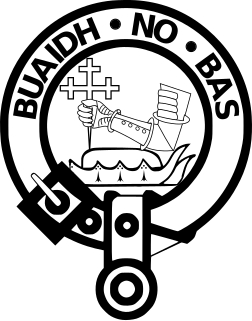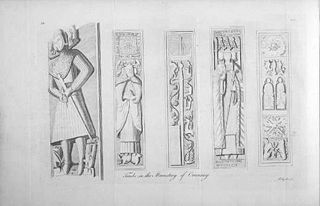
Clan Campbell is a Highland Scottish clan. Historically one of the largest and most powerful of the Highland clans, their lands were in Argyll and the chief of the clan became the Earl and later Duke of Argyll.

The House of Stuart, originally Stewart, was originally the royal house of Scotland, that later also ruled England, Ireland and in the end what came to be known as Great Britain, with historical connections to Brittany. The family name itself comes from the office of High Steward of Scotland, which had been held by the family scion Walter fitz Alan. The name "Stewart" and variations had become established as a family name by the time of his grandson, Walter Stewart. The first monarch of the Stewart line was Robert II whose descendants were kings and queens of Scotland from 1371 until the union with England in 1707. Mary, Queen of Scots was brought up in France where she adopted the French spelling of the name, Stuart.

Duke of Argyll is a title, created in the Peerage of Scotland in 1701 and in the Peerage of the United Kingdom in 1892. The Earls, Marquesses, and Dukes of Argyll were for several centuries among the most powerful noble families in Scotland. As such, they played a major role in Scottish history throughout the 16th, 17th, and 18th centuries. The Duke of Argyll also holds the hereditary titles of chief of Clan Campbell and Master of the Household of Scotland.

Colin Campbell, 1st Earl of Argyll, was a medieval Scottish nobleman, peer, and politician. He was the son of Archibald Campbell, Master of Campbell and Elizabeth Somerville. He had the sobriquet Colin Mulle, Bold Earl Colin.
Gillespie Archibald Campbell, 2nd Earl of Argyll was a Scottish nobleman and politician who was killed at the Battle of Flodden.
The sovereign or feudal lordship of Argyle was the holding of the senior branch of descendants of Somerled (Somhairle), this branch becoming soon known as Clan MacDougall
John MacDougall may refer to:

Clan MacDougall is a Highland Scottish clan, historically based in and around Argyll. The Lord Lyon King of Arms who is the Scottish official with responsibility for regulating heraldry in that country, issuing new grants of coats of arms, and serving as the judge of the Court of the Lord Lyon, recognizes under Scottish law the Chief of Clan MacDougall. The MacDougall chiefs share a common ancestry with the chiefs of Clan Donald in descent from Somerled of the 12th century. In the 13th century the Clan MacDougall whose chiefs were the original Lords of Argyll and later Lords of Lorne was the most powerful clan in the Western Highlands. During the Wars of Scottish Independence the MacDougalls sided with the Clan Comyn whose chiefs rivaled Robert the Bruce for the Scottish Crown and this resulted in clan battles between the MacDougalls and Bruce. This marked the MacDougall's fall from power and led to the rise of their relatives, the Clan Donald, who had supported Bruce and also the rise to power of the Clan Campbell who were the habitual enemies of the MacDougalls and Clan Donald.

Clan Bruce is a Lowlands Scottish clan. It was a Royal House in the 14th century, producing two kings of Scotland, and a disputed High King of Ireland, Edward Bruce.
Cailean Mór Caimbeul is one of the earliest attested members of Clan Campbell and an important ancestor figure of the later medieval Earls of Argyll.

Lorne is an ancient province in the west of Scotland, which is now a district in the Argyll and Bute council area. The district gives its name to the Lynn of Lorn National Scenic Area, one of forty such areas in Scotland, which have been defined so as to identify areas of exceptional scenery and to ensure its protection from inappropriate development. The national scenic areas cover 15,726 ha, of which 10,088 ha are marine seascape, and includes the whole of the island of Lismore, along with neighbouring areas on the mainland such as Benderloch and Port Appin, and the Shuna Island.
Lord Innermeath is an extinct title in the Peerage of Scotland created c. 1471 for Walter Stewart, 1st Lord Innermeath. Stewart had previously been Lord of Lorne, but resigned that title - which came with substantial comital power - under pressure from James III; James wished to weaken the remaining power of the Black Douglases, who had been allies of Walter's uncle, The Black Knight of Lorn. Walter had in fact only held the Lordship of Lorne for a few days, following the murder of his brother, the former Lord of Lorne.

John of Islay was the Lord of the Isles (1336–1386) and chief of Clan Donald. In 1336, he styled himself Dominus Insularum, "Lord of the Isles"; because this is the first ever recorded instance of the title in use, modern historians count John as the first of the later medieval Lords of the Isles, although this rather broad Latin style corresponds roughly with the older Gaelic title Rí Innse Gall, in use since the Viking Age, and for instance, the even more similar Latin title dominus de Inchegal, applied to Raghnall Mac Somhairle in the mid-12th century. In fact John is actually styled Rí Innsi Gall or King of the Isles shortly after his death in a contemporary entry in the Irish Annals of Ulster.

Clan Stewart of Appin is the West Highland branch of the Clan Stewart and have been a distinct clan since their establishment in the 15th century. Their Chiefs are descended from Sir James Stewart of Perston, who was himself the grandson of Alexander Stewart, the fourth High Steward of Scotland. His cousin Walter Stewart, the 6th High Steward, married Marjorie Bruce, the daughter of King Robert the Bruce, and their son Robert II was the first Stewart Monarch. The Stewarts of Appin are cousins to the Royal Stewart Monarchy.
John of Argyll, was a Scottish nobleman of the early 14th century. He is often known to today as John Bacach, "the Lame", but there is no authority for that as a contemporary or near-contemporary nickname.
Dúghall of Lorne [or de Ergadia] was a late 14th century and early 15th century prelate in the Kingdom of Scotland. Probably a MacDúghaill (MacDougall) from the province of Lorne in Argyll, he appears to have studied at the University of Oxford before returning to Scotland for an ecclesiastical and administrative career. He obtained benefices in the diocese of Argyll, Dunkeld, Dunblane and St Andrews, and acted as the secretary and chaplain of Robert Stewart, Earl of Fife, before becoming Bishop of Dunblane. He held the bishopric of Dunblane until his death in 1403.
James Stewart, the Black Knight of Lorne (c.1399–c.1451) was a Scottish nobleman.
John Gallda MacDougall, also known as John MacDougall, and John Macdougall, and in Gaelic as Eoin MacDubhghaill, Eoin Gallda MacDubhghaill, Eòin Gallda MacDubhghaill, and Eóin Gallda Mac Dubhghaill, was fourteenth-century Scottish magnate. He was a grandson of John MacDougall, Lord of Argyll, a man who had been forced from Scotland into exile in the first third of the century. It was under John Gallda that the MacDougall leadership made its resurgence in Scotland after generations of English exile.

The Battle of Stalc was a Scottish clan battle that was fought in the year 1468. It was fought between the forces of the Clan Stewart of Appin and their allies the Clan MacLaren against the Clan MacDougall and the Clan MacFarlane. The latter force may have included men from the Clan Campbell.
James Stewart, 5th Lord Innermeath was a Scottish courtier and landowner.












